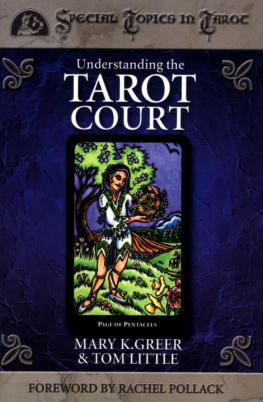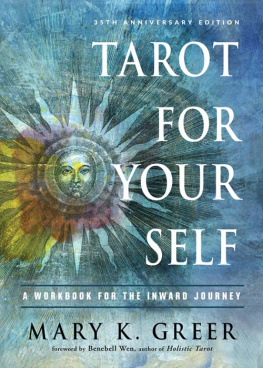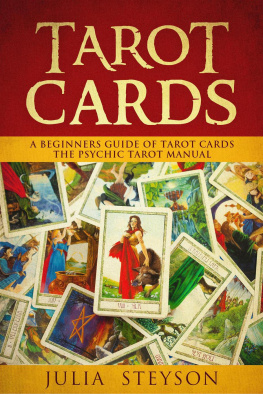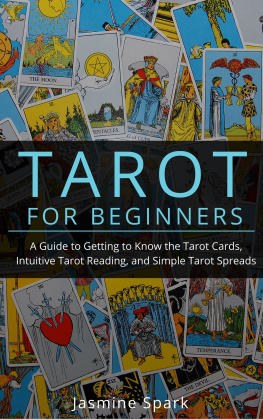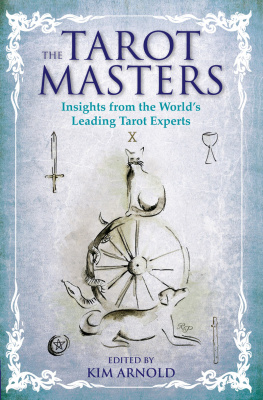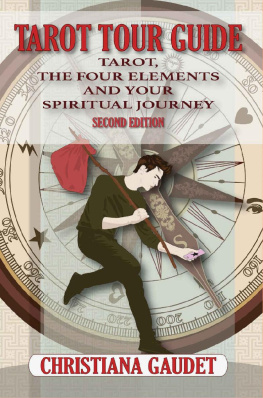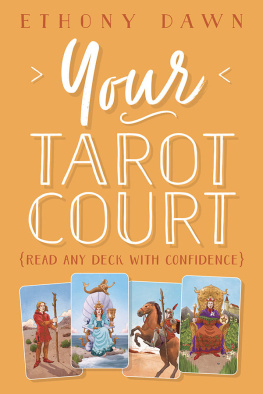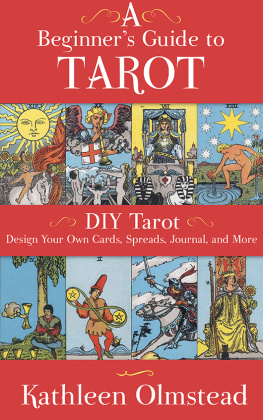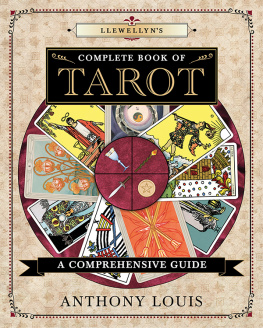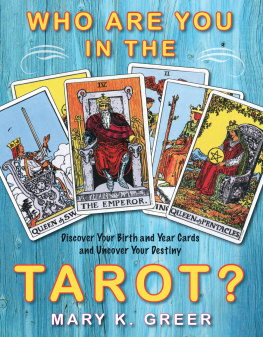Mary K. Greer - Understanding the Tarot Court (Special Topics in Tarot Series)
Here you can read online Mary K. Greer - Understanding the Tarot Court (Special Topics in Tarot Series) full text of the book (entire story) in english for free. Download pdf and epub, get meaning, cover and reviews about this ebook. year: 2008, publisher: Llewellyn Publications, genre: Home and family. Description of the work, (preface) as well as reviews are available. Best literature library LitArk.com created for fans of good reading and offers a wide selection of genres:
Romance novel
Science fiction
Adventure
Detective
Science
History
Home and family
Prose
Art
Politics
Computer
Non-fiction
Religion
Business
Children
Humor
Choose a favorite category and find really read worthwhile books. Enjoy immersion in the world of imagination, feel the emotions of the characters or learn something new for yourself, make an fascinating discovery.
- Book:Understanding the Tarot Court (Special Topics in Tarot Series)
- Author:
- Publisher:Llewellyn Publications
- Genre:
- Year:2008
- Rating:3 / 5
- Favourites:Add to favourites
- Your mark:
- 60
- 1
- 2
- 3
- 4
- 5
Understanding the Tarot Court (Special Topics in Tarot Series): summary, description and annotation
We offer to read an annotation, description, summary or preface (depends on what the author of the book "Understanding the Tarot Court (Special Topics in Tarot Series)" wrote himself). If you haven't found the necessary information about the book — write in the comments, we will try to find it.
Understanding the Tarot Court (Special Topics in Tarot Series) — read online for free the complete book (whole text) full work
Below is the text of the book, divided by pages. System saving the place of the last page read, allows you to conveniently read the book "Understanding the Tarot Court (Special Topics in Tarot Series)" online for free, without having to search again every time where you left off. Put a bookmark, and you can go to the page where you finished reading at any time.
Font size:
Interval:
Bookmark:


Mary K. Greer specializes in writing about and teaching methods of self-exploration and transformation. The author of six books on Tarot and a member of several Tarot organizations, she is featured at Tarot conferences and symposia around the United States and abroad. She has a wide following in feminist and pagan communities for her work in women's spirituality and magic. A priestess-hierophant in the Fellowship of Isis, she is founder of the Iseum of Isis Aurea.
Mary has studied and practiced Tarot and astrology for over thirty-five years. Her teaching experience includes eleven years at a liberal arts college and hundreds of worshops, conferences, and classes. She is the founder and director of the learning center T.A.R.O.T. (Tools And Rites Of Transformation). She coauthored the TarotL History Information Sheet.
Tom Little is a health physicist at Los Alamos National Laboratory. He holds a PhD in astronomy from New Mexico State University and has previously worked as a university professor and a technical writer. He is a Wiccan priest and serves on the board of Ardantane pagan learning center in northern New Mexico.
Tom has used the Tarot as his primary spiritual tool for a number of years. He has a strong interest in Tarot history and antique decks, and has created extensive online resources for Tarot enthusiast, including the Hermitage (a Tarot history site, www.tarothermit.com) and Tarot at Telperion Productions (www.telp.com/tarot/). He has coauthored and edited the TarotL Tarot History Information Sheet. He lives in Santa Fe, New Mexico.

MARY K. GREER & TOM LITTLE
Complete Book of Tarot Reversals (Llewellyn, 2002)
Tarot for Your Self, revised edition (New Page Books, 2002)
Women of the Golden Dawn (Park Street Press, 1995)
The Essence of Magic (Newcastle, 1993)
Tarot Mirrors (New Page Books, 1988)
Tarot Constellations (New Page Books, 1987)

... ix
... xiii
... 1
Chapter ... 5
Chapter ... 27
Chapter ... 41
Chapter ... 63
Chapter ... 85
Chapter ... 105
Chapter ... 135
Chapter ... 157
Chapter ... 173
... 223
... 227
... 229
... 245
... 253
... 257

 -f you teach classes or workshops in Tarot, and you ask for questions, .you will always get two questions among the rest. The first is "How do we read reversed cards?" and the second is "How do we interpret the court cards?" Mary Greer has come to our aid for the first with her truly Complete Book of Tarot Reversals, and now she and Tom Little, like true Tarot knights, have ridden to our rescue with this marvelous and thorough adventure in court card interpretation.
-f you teach classes or workshops in Tarot, and you ask for questions, .you will always get two questions among the rest. The first is "How do we read reversed cards?" and the second is "How do we interpret the court cards?" Mary Greer has come to our aid for the first with her truly Complete Book of Tarot Reversals, and now she and Tom Little, like true Tarot knights, have ridden to our rescue with this marvelous and thorough adventure in court card interpretation.
The reason why people have trouble with the court cards is really not a mystery. They just don't do all that much. The modern history of Tarot is largely a history of interpretation. Beginning in the last quarter of the twentieth century Tarot enthusiasts have sought to enter the pictures rather than have a standard set of formulaic meanings or a structural system to understand them. They will look at, say, the Five of Pentacles, and ponder what the people in the card are doing, where they are, what expressions they show and what body posture they hold, what might have happened to them in the past, what choices they might make in the future. All this then applies to the person who received the card in the reading and whatever question the person might have asked.
Until about a century ago this process was impossible, since the greater part of the deck, the forty pip cards (ace-ten in the four suits) showed no pictures at all, just elegant patterns of the suit emblems arranged on the card. In other words, the Six of Cups would not show any people or scene, just six elaborate cups in some sort of pattern, much the way we see the Six of Hearts in an ordinary playing card deck. This changed dramatically with the Rider-Waite-Smith deck, published in 1910. Working with the designer, Arthur Edward Waite, Pamela Colman Smith drew action scenes on all the pip cards. A sense of story entered the minor arcana, and story makes interpretation possible. Go to a movie with a friend and talk about it afterward, and you will discover how much opportunity story gives all of us to discover our own truths.
Along with the narrative quality of the pip cards, the trump cards, or major arcana, had always presented us with suggestions of complex symbolism. The court cards, however, were a problem. Until recently, the courts in most decks (the Thoth deck of Aleister Crowley and Frieda Harris was a notable exception) presented themselves in rather staid fashion. The kings and queens sat on their thrones, the knights charged on their horses, and the pages stood proudly holding their suit emblems.
In the older styles of Tarot reading, this formal quality of the courts actually worked rather well. This is because readers assumed that these cards referred to specific people, and you could identify those people with set formulas, such as age, sex, and hair and skin color. Such identification, however, is not the same as interpretation.
Greer and Little address the tradition that court cards refer to people. They consider it as one of the many possible ways to see these cards. Rather than just give us formulas, however, they come up with inventive and playful ways to figure out who the court figures might be. And they suggest methods so that we can sense if a card really does refer to a person, or one of the many other possibilities the book offers us.
Play is a hallmark of this book. Greer and Little know that when we play with images, ideas, possibilities, we give ourselves the chance to discover truth. And so, among many other techniques, we find an invitation to a "Tarot beach party." Later on, they show us how to create stories and screenplays out of Tarot cards, with the courts as a readymade cast of characters. I hope that someone does indeed film their script idea. It's a good one.
A good deal of the techniques in this book show the influence of the modern therapy movement, especially Jung and Perls. Just as Gestalt therapists tell their clients to see every thing in a dream (even inanimate objects) as themselves, so Greer and Little tell us that "the single most powerful way" to view the court cards is as facets of the questioner's personality. This might be just a provocative idea if they did not also give us so many wonderful techniques. One of my favorites is the suggestion that we actually get the court cards in a reading to speak. Suppose you are using the Rider-Waite deck, and you get the Ten of Swords, the man with the ten swords sticking out of his back, and then the Knight of Wands. Can you imagine the knight coming across this scene? What would he do? What would he say about it? I happen to be writing this on Arthur Conan Doyle's birthday, so my own impulse is to imagine the Knight of Wands as a detective, investigating the Ten of Swords crime scene. But that's just one version. Try it for yourself. And then consider that as an aspect of your personality and see what it tells you.
Font size:
Interval:
Bookmark:
Similar books «Understanding the Tarot Court (Special Topics in Tarot Series)»
Look at similar books to Understanding the Tarot Court (Special Topics in Tarot Series). We have selected literature similar in name and meaning in the hope of providing readers with more options to find new, interesting, not yet read works.
Discussion, reviews of the book Understanding the Tarot Court (Special Topics in Tarot Series) and just readers' own opinions. Leave your comments, write what you think about the work, its meaning or the main characters. Specify what exactly you liked and what you didn't like, and why you think so.

